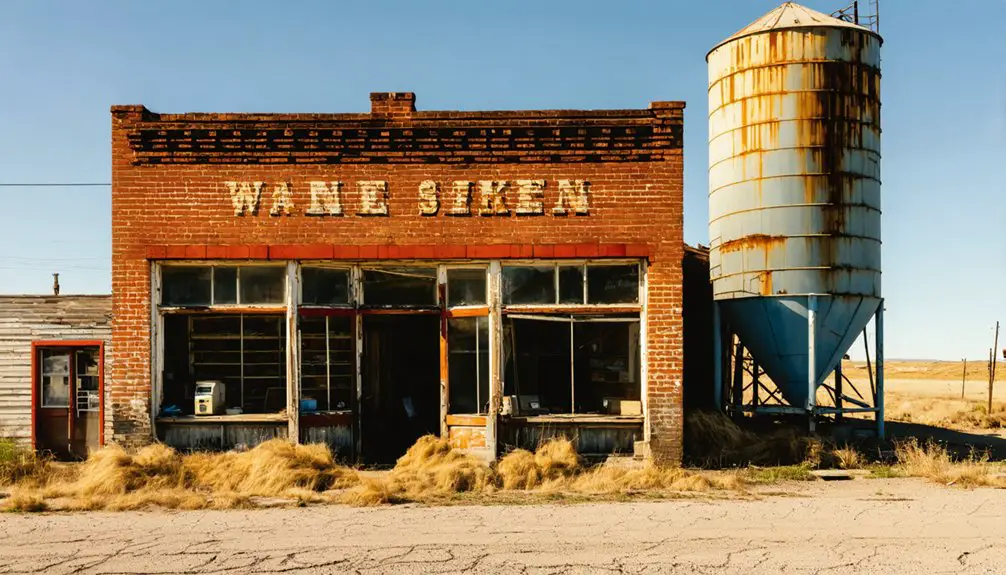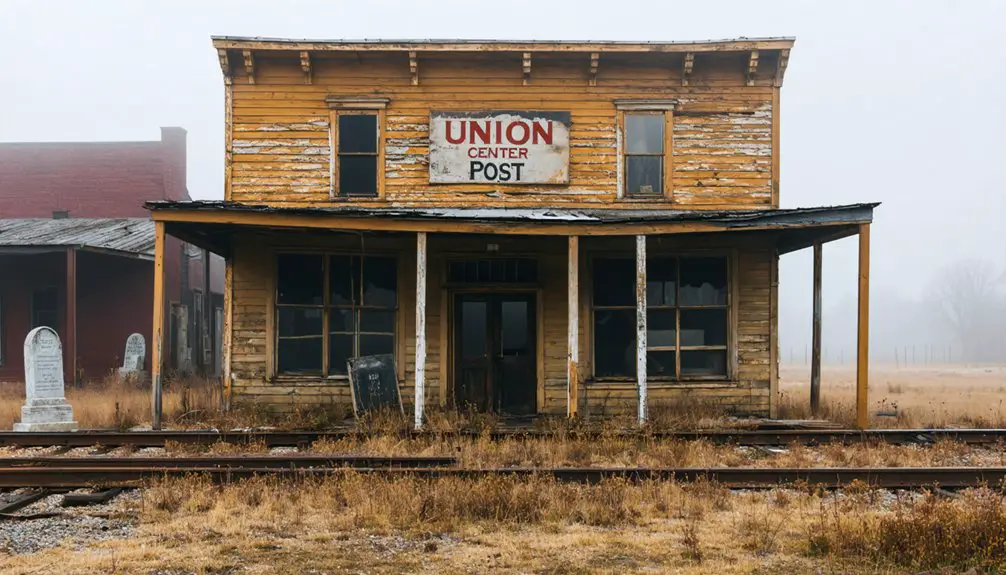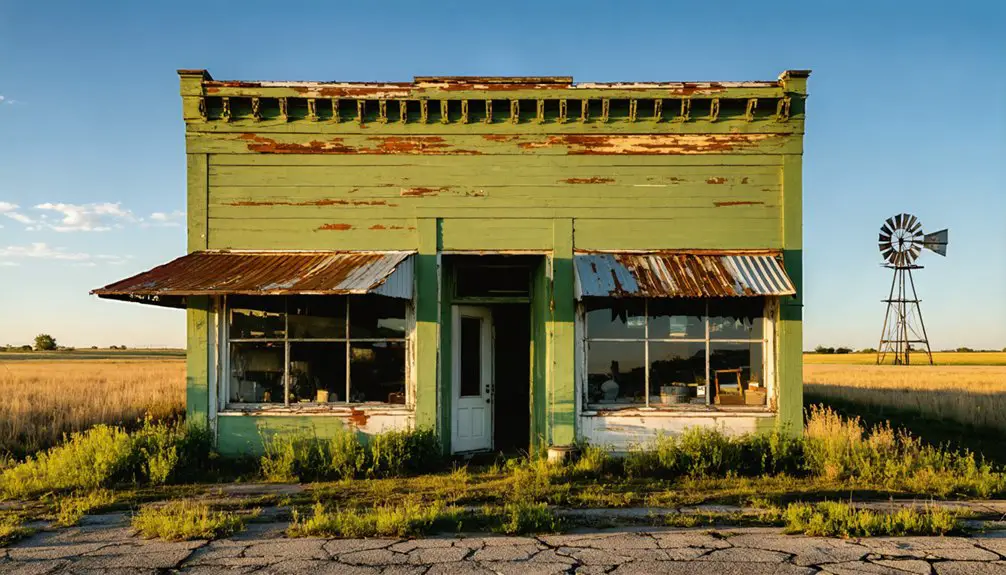You’ll find Union Center’s ghost town remnants along the Kansas River, where it once thrived as a major trading post serving Potawatomi Indians and westbound emigrants. Founded in March 1848, it quickly grew to 60 buildings with 300 residents by early 1849. The settlement’s promising future ended abruptly when a devastating cholera epidemic struck that summer, killing half the population and sending survivors fleeing. The site’s layers of history tell a complex tale of frontier dreams and tragedy.
Key Takeaways
- Union Center was established in 1848 as a thriving trading post along the Kansas River, serving Potawatomi Indians and westbound settlers.
- At its peak in 1849, the settlement boasted 60 buildings, including 14 stores, and supported approximately 300 residents.
- The devastating cholera epidemic of 1849 killed roughly half the population within months, causing survivors to flee.
- The town’s rapid decline from bustling trade center to ghost town status was primarily due to the cholera outbreak.
- Archaeological evidence shows cultural exchanges between settlers and Native Americans, though few physical remains of the settlement exist today.
Origins and Early Development
Seeking to establish a strategic trading post for the Potawatomi Indians, the U.S. government founded Uniontown in March 1848 near present-day Rossville, Kansas.
You’ll find the town’s significance reflected in its rapid growth to 60 buildings, including 14 stores, making it the largest trading hub on the Kansas River for the Potawatomi nation.
The government’s vision extended beyond commerce – they’d designed Uniontown as an administrative center to unify semi-autonomous Potawatomi bands under centralized governance.
Uniontown served as more than a marketplace – it was the government’s tool for consolidating scattered Potawatomi bands under central authority.
They strategically positioned the settlement along the Kansas River, where you’d have found a popular river crossing that travelers preferred over the nearby Pappan Ferry due to its gentler currents and shallower waters.
Like the bustling Union Station of 1914, this location proved essential for both Native American trade and westward emigrants.
Thomas N. Stinson built the first house in the new settlement in 1848, marking the beginning of permanent structures in the area.
Life Along the Oregon-California Trail
As westbound emigrants poured through the Kansas Territory in increasing numbers, Union Center emerged as an essential waypoint along the Oregon-California Trail network. Independence Landing sites served as crucial starting points for many travelers embarking on their westward journey.
You’d witness a constant flow of wagons passing through, carrying hopeful settlers heading west and occasional discouraged travelers returning east. The trail’s challenges shaped daily life, as Native American tribes like the Shawnee and Kanza influenced both trail guidance and settler relations. After the discovery of gold in 1848, the number of travelers increased dramatically as fortune seekers rushed to California.
- Heavy wagon traffic transformed the landscape, creating lasting marks on the terrain near Union Center and other Kansas settlements.
- You’d find emigrants stocking up on provisions from nearby towns like Lawrence and Kansas City.
- Local forts provided protection and support for travelers traversing this essential segment.
- The intersection of multiple trail routes made Union Center a strategic point for monitoring emigrant experiences and movement patterns.
Commercial Peak and Trading Activities

You’ll find Uniontown’s bustling commercial operations centered around its trading post, which served both Native Americans and westward emigrants during its 1849 peak.
The post’s strategic location near the Kansas River allowed traders like Robert Kinzie and the Ewing brothers to conduct extensive business, offering everything from foodstuffs to firearms. The area saw daily traffic comparable to the Beaux-Arts style architecture that would later define the region’s grand terminals.
The settlement’s commercial success drew nearly 300 residents and supported around 60 buildings, including essential services like blacksmiths, wagon makers, and gunsmiths.
Much like Kansas City’s Union Station, the area thrived as a major transportation and commerce hub during its heyday.
Trading Post Operations
The trading post at Union Center began operations in 1825 when Cyprian Chouteau established it under a licensed agreement to trade with Indian tribes west of the Missouri River.
You’d find the trading post serving as an economic foundation for early Kansas settlement, facilitating crucial exchanges between settlers and native tribes in a region without established roads or towns.
- Pack horses transported goods from St. Louis to exchange for animal furs
- Basic structures housed fundamental trade items like food, tobacco, weapons, and gunpowder
- Candles and lanterns lit the frontier outpost amid wilderness isolation
- Trade relations focused primarily on the Osage tribe and other native peoples
Similar to Kansas City’s later Union Depot, which would become a vital commerce hub in 1878, the trading post acted as a central point of regional trade and development.
The post’s commercial significance grew with the addition of a flour mill in 1857 and a second store near the bridge in 1858.
By 1880, the bustling community had expanded to include three general stores, a drug store, and two blacksmith shops.
River Commerce Impact
While early river commerce defined Union Center’s economic prosperity, the town’s strategic location near major waterways proved both beneficial and challenging for trade operations.
You’d find peak commercial activity during navigation seasons, when riverboats converged with traders and merchants at the bustling waterfront.
River transport enabled the movement of agricultural goods and raw materials, making Union Center a crucial hub for regional trade. The devastating floods of 1903, 1904, and 1908 were particularly destructive to the area’s commercial activities.
However, flood challenges repeatedly damaged riverside warehouses and trading facilities, disrupting commerce continuity.
These setbacks ultimately pushed businesses to relocate to higher ground, especially as railroad infrastructure expanded away from flood-prone areas.
The shift marked a turning point in Union Center’s commercial landscape, as the town adapted to embrace rail transport while gradually reducing its dependence on river commerce, similar to how twelve railroad companies united to establish more reliable transportation networks in the region.
Peak Business Activities 1849
During Union Center’s commercial zenith in 1849, bustling general stores and blacksmith shops dominated the town’s economic landscape, serving as essential hubs for both settlers and travelers.
You’d have witnessed remarkable business expansion as the fertile Kansas plains attracted more farmers and merchants. The town’s strategic location facilitated agricultural innovation, with trading posts connecting local producers to broader markets.
- General stores stocked diverse goods from eastern manufacturers, while local artisans crafted furniture and shoes.
- Warehouses and stockyards emerged to support growing livestock trade and grain storage.
- Horse-drawn wagons transported goods along improving frontier roads.
- Various ethnic settlers brought diverse market demands, transforming Union Center into a dynamic trading center.
The town’s commerce thrived on rising agricultural production, frontier defense needs, and the approaching Kansas Territory admission.
Impact of the 1849 Cholera Epidemic

You’ll find that Union Center’s population plummeted during the devastating 1849 cholera epidemic, as terrified settlers fled the region in large numbers, mirroring the mass exodus seen in nearby Uniontown.
The town’s few remaining residents struggled to obtain basic medical supplies, with local merchants’ stocks quickly depleted as the disease spread through Kansas Territory settlements.
The shortage of medicine became particularly acute when neighboring communities, also battling the epidemic, couldn’t spare any supplies through their usual trading networks.
Rapid Population Loss
As cholera swept through Union Center in 1849, the town’s population plummeted at an alarming rate, with roughly half of its settlers succumbing to the disease within months.
You’ll find that community resilience crumbled under the devastating daily death toll, with cemetery records showing shocking burial surges. Migration patterns shifted dramatically as survivors fled to escape infection, contributing to the town’s eventual ghost town status.
- Nearby Madison reported 163 deaths during the epidemic’s peak months
- Multiple deaths occurred nightly, creating widespread fear and uncertainty
- Labor shortages halted regional development and agricultural production
- Traditional social structures collapsed as groups split into smaller units for survival
The rapid population decline proved insurmountable for Union Center’s remaining residents, who couldn’t sustain their once-thriving community in the face of such devastating losses.
Local Medicine Shortages
While Union Center’s population dwindled from cholera in 1849, a severe shortage of medical supplies compounded the crisis. You’d have found the town’s few physicians struggling with critical medical supply shortages, especially quinine sulfate, which they’d desperately repurpose despite dosing uncertainties.
The epidemic overwhelmed Union Center’s limited healthcare capacity, leaving doctors to improvise with impure medicines.
The region’s isolation made cholera treatment challenges even worse. You couldn’t count on regular supply deliveries, as hazardous travel conditions and quarantine measures disrupted medical transport routes.
Local medical staff faced impossible choices, rationing what little medicine they’d while dealing with overcrowded conditions. The high cost of available drugs, combined with the shortage of trained caregivers, left many frontier families without access to proper treatment.
Native American Relations and Government Policies
The story of Union Center’s Native American relations reflects the broader upheaval that transformed Kansas during the 19th century. Federal policies forced dramatic changes as the government pushed tribes from their ancestral lands through a series of Native American treaties.
What you’ll find in Union Center’s history mirrors the larger pattern of displacement that affected nearly 30 tribes across Kansas Territory.
- The area was originally home to Kansa villages, with at least 20 settlements along the Kansas Valley before forced relocation.
- Federal Indian removal policies in the 1820s designated Kansas as Indian Territory, only to later push tribes into Oklahoma.
- Sacred sites and burial grounds faced constant threats from development and urban expansion.
- The government’s actions disrupted traditional tribal movements and trading patterns that had existed for generations.
Archaeological Findings and Historical Legacy

Located along the historic Oregon-California Trail, Uniontown’s archaeological legacy reveals a complex trading hub that once bustled with 300 residents and 60 buildings, including 14 stores.
Today, you’ll find sparse physical remains of this once-thriving settlement, as both Uniontown and nearby Plowboy have virtually vanished from the landscape.
The archaeological stratigraphy tells a story of cultural exchanges between Native Americans, settlers, and gold rush migrants.
The site’s strategic location near a superior river crossing point attracted diverse groups, though the 1849-1850 cholera epidemic dramatically disrupted settlement patterns.
Evidence of government attempts to centralize Potawatomi bands can be traced through settlement layouts, while scattered artifacts reflect the community’s brief but significant role as a commercial and social center before its ultimate abandonment.
Frequently Asked Questions
What Happened to the Buildings and Materials From Uniontown After Abandonment?
You’ll find materials were salvaged during urban decay, with many items auctioned off in 1976. Historical preservation efforts saved key architectural elements, while remaining structures underwent careful dismantling for reuse or sale.
Were There Any Notable Individuals or Families Who Survived the Epidemic?
From a town of 300, you won’t find specific names of epidemic survivors in historical records. While some Potawatomi families likely endured, details of notable families who survived remain frustratingly unclear.
How Did Local Weather Patterns and Natural Disasters Affect Uniontown’s Development?
You’ll find that drought impacts severely limited agricultural success, while unpredictable flood consequences damaged infrastructure. The harsh weather patterns ultimately contributed to Uniontown’s instability and eventual decline through economic hardship.
What Types of Currency and Trading Methods Were Used in Uniontown?
You’d find silver coins for official payments, while daily trade relied on bartering goods like crops and furs. Currency exchange happened through government agents, and informal trade goods moved along the Oregon-California Trail.
Did Any Religious Organizations or Churches Establish Themselves in Uniontown?
You won’t find evidence of formal churches in Uniontown – records don’t show any religious organizations setting up there. While religious influence existed through Potawatomi spiritual practices, Western-style church history wasn’t established.
References
- https://octa-trails.org/wp-content/uploads/2023/05/Ellis-Uniontown-and-Plowboy–-Potawatomi-Ghost-Towns.pdf
- https://www.kshb.com/news/local-news/the-sounds-of-crowds-footsteps-from-another-time-still-echo-in-union-station-photo-historian-says
- https://legendsofkansas.com/uniontown-shawnee-county-kansas/
- https://www.americanhauntingsink.com/kansascity
- https://octa-trails.org/archaeology/uniontown-and-plowboy-potawatomi-ghost-towns-enigmas-of-the-oregon-california-trail/
- https://en.wikipedia.org/wiki/Kansas_City_Union_Station
- https://lplks.org/wp-content/uploads/sites/56/2018/04/Hike-Through-History-Page-8.pdf
- https://en.wikipedia.org/wiki/California_Trail
- https://www.youtube.com/watch?v=fvtcMW4Pumg
- https://npshistory.com/publications/oreg/index.htm



